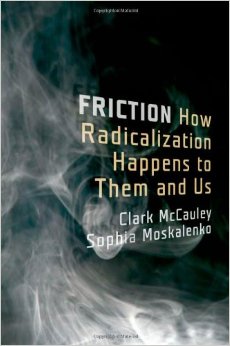A new online article on the role of religious belief among Islamists supporting violence (an overlapping theme of these posts). The article by specialists in the field draws the some of the same comparisons I have been making between the appeal of religious cults and political extremist movements:
The Cult of Jihad: A Practical Theology Perspective on ISIS, a scholarly guest post by Joel Day and Scott Kleinmann in Political Violence @ a Glance (Expert Analysis on Violence and Its Alternatives).
Of particular interest to me is another article cited in “The Cult of Jihad”, and that is “The Study of New Religious Movements and the Radicalization of Home-Grown Terrorists: Opening a Dialogue” by Lorne L. Dawson in Terrorism and Political Violence, 22:1, 2009. From the abstract:
This article examines:
(1) the obvious reasons for, and curious absence of, a dialogue between scholars studying new religious movements (NRMs), particularly those responsible for acts of mass violence, and those studying processes of radicalization in home-grown terrorist groups;
(2) the substantial parallels between established understandings of who joins NRMs, how, and why and recent findings about who joins terrorist groups in a Western context, how, and why; and
(3) the ways in which explanations of the causes of violent behaviour in NRMs are pertinent to securing a more systematic and complete grasp of the process of radicalization in terrorist cells.
The latter discussion focuses on the role of apocalyptic belief systems and charis- matic forms of authority, highlighting the behavioural consequences of this danger- ous combination and their possible strategic significance. . . .
Another new article of related interest is What Does It Mean If An Attack Is ‘ISIS-Inspired’?
H/T http://intelwire.egoplex.com/ (J. M. Berger, co-author of ISIS: the State of Terror)
We have seen the process by which some people are attracted to extremist groups and have reached the point of examining how a subset of those individuals are drawn to cross the line from intellectual sympathy to committing themselves to the high risks of active support for violence. (The argument that we have been presenting is from Quintan Wiktorowicz’s Radical Islam Rising. Wiktorowicz takes the now-banned jihadist group in Great Britain, al-Muhajiroun, as a case-study.)
To recap:
- Many people at some time face a crisis that leads them to question their life-long assumptions and beliefs and opens them to a willingness to seriously consider radically new world-view perspectives. Crises can vary from death in a family to a feeling of not belonging in one’s “homeland”, a result of the combination of experiencing racial discrimination and alienation from the foreign culture of one’s migrant parents.
- Seekers are more likely to respond to groups with the following factors:
- the trained representatives of the group are able to discuss questions of interest to the seekers (not only political questions; literature of the group covers a wide range of topics);
- the extremist group conveys a sense of credibility and spiritual authority by means of
- the charismatic personality of the leader
- its ability to convey a depth and breadth of knowledge and understanding of questions of interest to the seeker and of the alternative answers (Wiktorowicz’s notes that the more devout Muslims have a deeper knowledge of how their religion relates to such questions and are not attracted to the simplistic idiosyncratic interpretations of the extremists; those who are most often attracted have had very little prior religious interest.)
- the rationality of its arguments
- the tactic of giving the seeker a sense of being in control of his journey towards the extremist’s point of view (e.g. the seeker will be encouraged to investigate rival groups)
- the extremist group hides its extremist views through front organisations and strategically planned discussions/messages
|
The relative few who are led to intellectual agreement with extremist views through this process are still a long way from turning their backs on society to the extent that they are potential suicidal mass murderers.
That’s where “culturing” enters the picture.
Through regular classes “seekers” are socialized into the movements ideology. We have seen how these classes and related activities increasingly consume so much of the individual’s time that there is little room left for serious arms-length reflection on the direction into which the path is leading. And it certainly helps when the seeker has had little or no serious religious engagement prior to encountering the new movement and against which they would otherwise be more capable of assessing the new teachings.
The Islamist extremist (and the member of other religious cults as well) sees him or herself as belonging to a pioneering vanguard of a new way of life that with the authority of Heaven is destined to replace all “human systems”. In the case of the Islamist (the term refers to one who believes in politically imposing Islamic law over society) that new way of life or ideology is destined to replace Capitalism and Democracy (the two go together in Islamist thinking). Democracy is interpreted as an anti-godly effort to replace God as the law-giver and ruler of society.
The mind-set that is inculcated as part of the “culturing” into the extremist movement’s revolves around its own sectarian interpretation of tawhid, or the “oneness of God”. Since God is the only lawgiver then anyone who supports democracy or even follows the wisdom of mainstream imams is said to be worshiping authorities other than God. We saw how some of this works out in detail in the previous post. — Recall that Islamic regimes in the Middle East are judged to be apostate because they countenance some form of democracy and enforce laws that are inconsistent with pure Sharia.
Other Muslims, moreover, argue that judging others as apostate is akin to murdering them since without the utmost stringent proofs only God can know the mind of another.
We look now at the ideology into which Islamist extremists are “cultured”. The ideology into which they are ever more deeply immersed through regular meetings, classes and activities, Wiktorowicz argues, is what leads them ever closer to the point of believing that their own personal salvation depends on a willingness to lose everything in this life and even to make others pay with their own lives, too.
We begin by looking at the source of the extremist’s ideology. The Quran is not enough for their ideological needs.
Preparations for an Islamic State
The Islamists look to the life of Muhammad (not found in the Quran) for guidance in or rationalisation of their program. There is a difficulty, not insurmountable, however. The Prophet’s life spanned many years through different environments — exile and conquest, for example. Islamist leaders therefore select what they believe to be the period in Mohammed’s life that is analogous to today’s situation for the radicals and make a judgement on how to apply the analogous act today. Continue reading “Violent Islamism: Many Are Called, Few Are “Chosen”, Fewer Defect”
Like this:
Like Loading...


